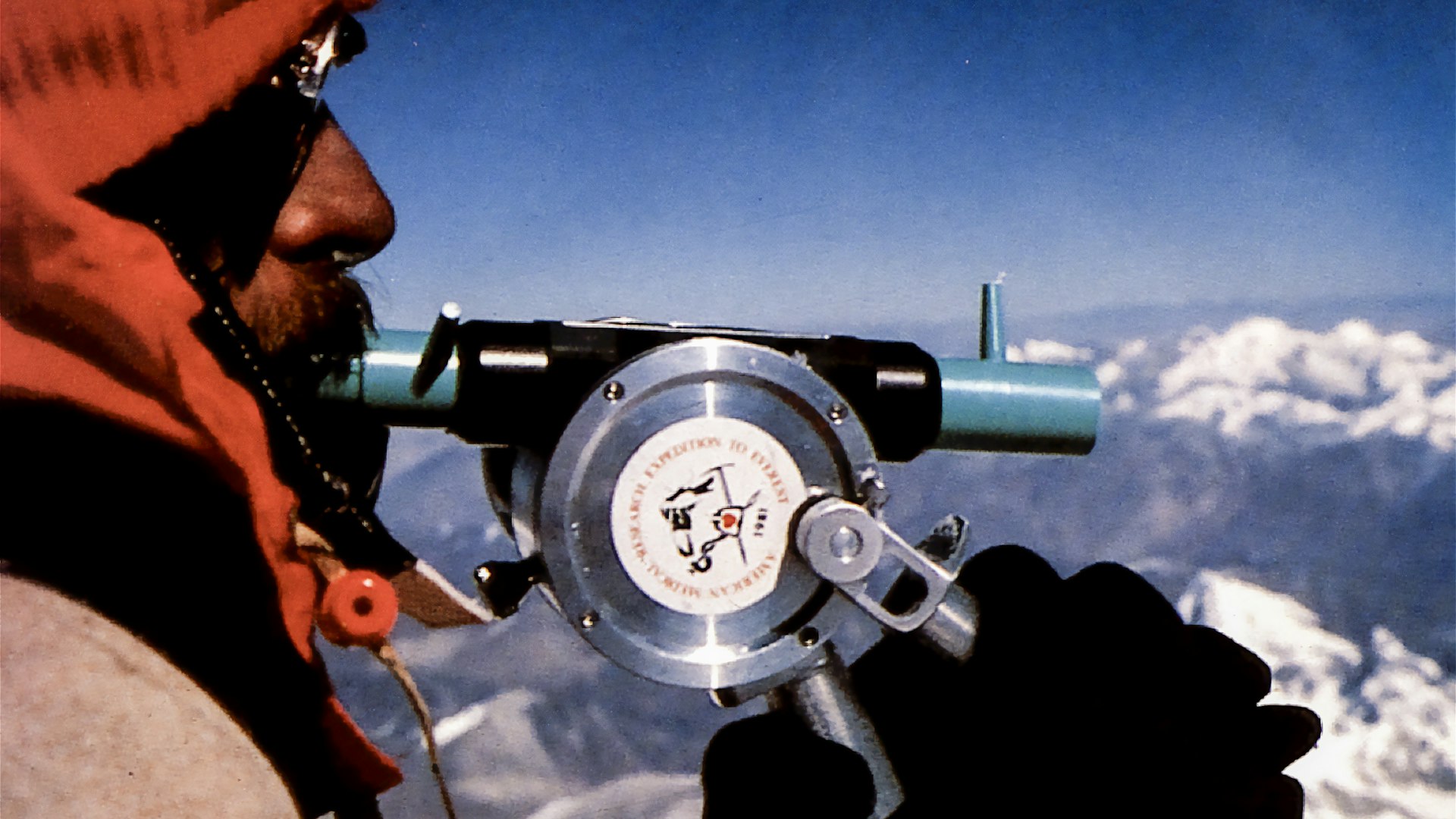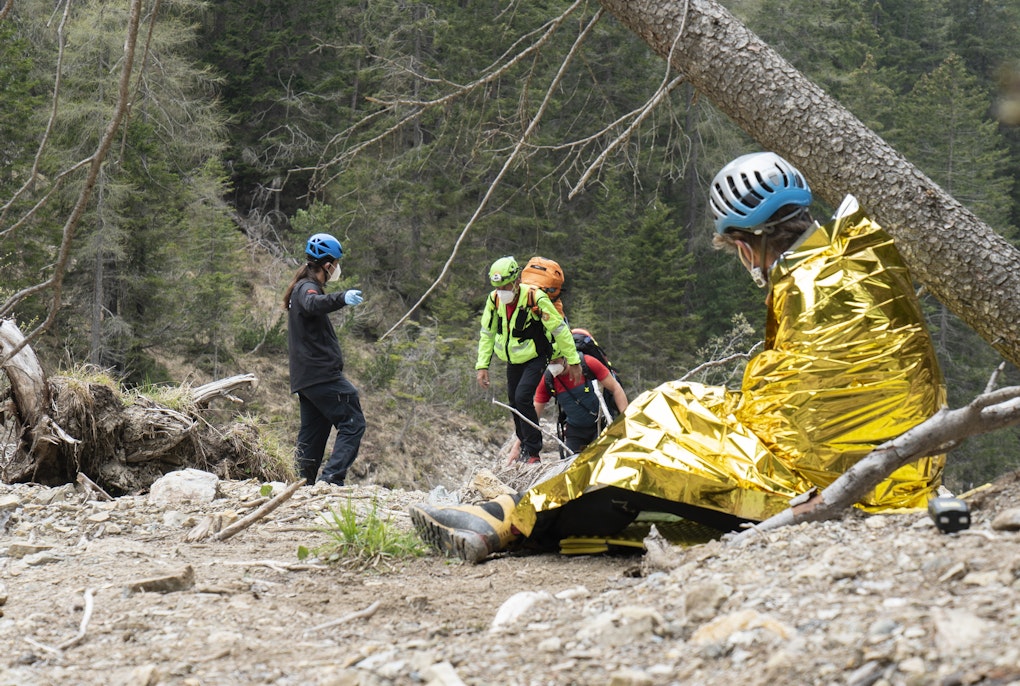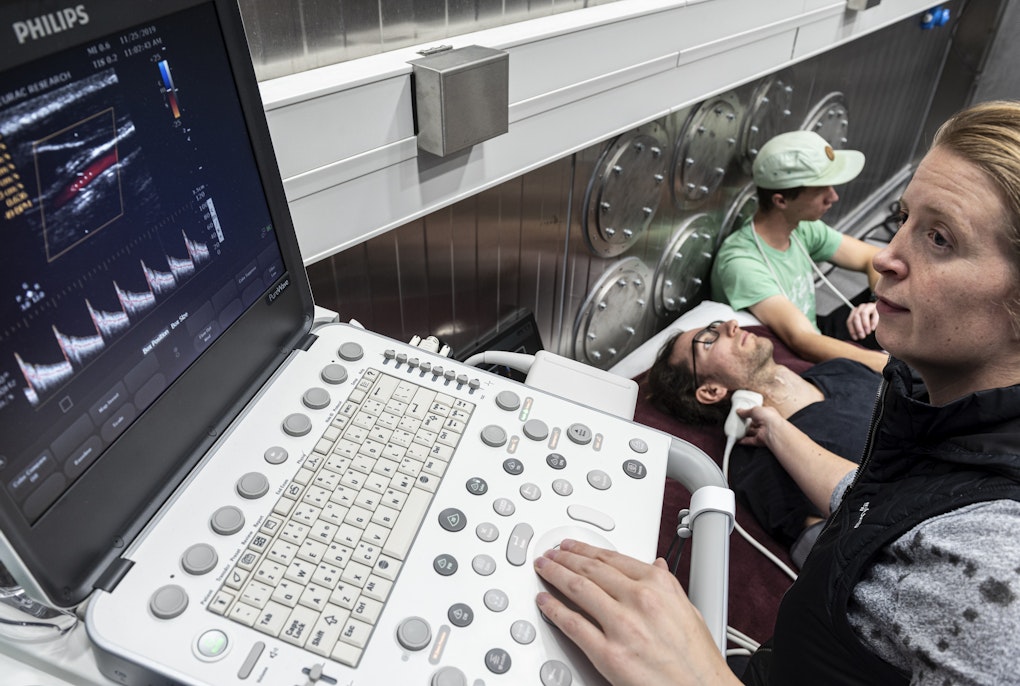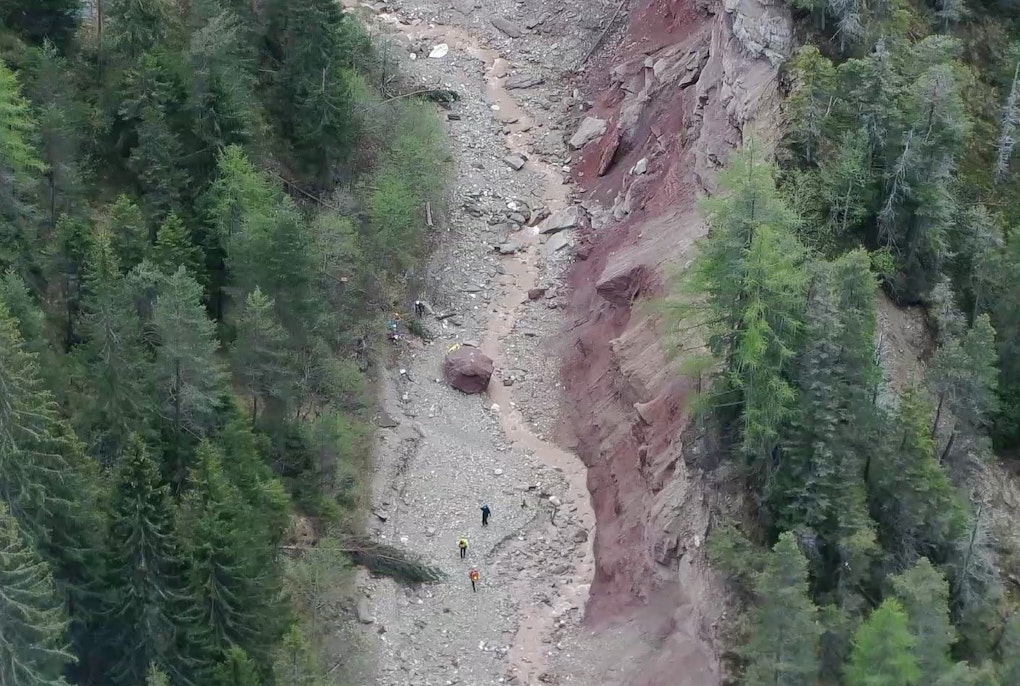magazine_ Article
Can science explain mountaineering?
Studies on human physiology often accompany great mountaineering feats, however the results of these studies are at times, contradicted by reality.
Doctor Chris Pizzo, a member of the American Medical Research Expedition to Everest (AMREE), takes samples of his alveolar gases at the summit of Mount Everest. The year is 1981.
Credit: American Physiological Society | All rights reserved
In the 1950s, when interest in the 8.000s was growing worldwide, knowledge of human physiology at extreme altitudes was very scarce. The little information that had been gathered in the field was supplemented by laboratory experiments and hypothesis projections. In the following decades, daring medical studies at altitude collected ever more detailed data. Even today, the search is still on for the perfect test: the physiological factors predictive of a successful venture to altitude. Usually, however, it was mountaineering expeditions themselves that revolutionized scientific opinion.
Is it possible to reach the summit of at 8848+ meter summit of Everest without using supplementary oxygen? South Tyrol’s Reinhold Messner and Austria’s Peter Habeler answered this question in 1978 with the first, incredible ascent without oxygen tanks. The feat changed the history of mountaineering. But even up until the 1980s, this was still the big question tormenting both mountaineers and those who studied the functioning of the human body at extreme altitudes alike. From a scientific point of view, supplementary oxygen seemed to be essential, and the 1978 feat was considered something of an inexplicable exception.
The science of altitude was still in its preliminary stages. A few decades earlier, after the Second World War, the eight-thousanders were still completely unexplored territory, both in terms of mountaineering and scientifically. There was no data and the knowledge of the reactions of the human body at those altitudes was almost nil. What was attempted was to make projections based on the rare measurements available or to simulate the altitude in a laboratory.
One of the first such experiments took place in 1946 inside the Pensacola, Florida’s Naval Air Station which housed a tiny steel hypobaric chamber operated by the US Navy. Four mountaineers were taken to an altitude of 8846 m.a.s.l in 33 days, even reaching a simulated altitude of 15,000 metres for a just a few minutes. The test subjects were fortunately followed by a large team of about 40 medical, mechanical, and technical personnel. The study which later became known as Operation Everest I. The study aim: investigate the physiological changes in the human body at altitude with and without supplementary oxygen. For the first time, a human body reached those altitudes and for the first time, consequences of altitude such as hypoxia – the lack of adequate oxygen in the body– could be monitored and evaluated by the scientific personnel sitting comfortably outside the simulation chamber.
A few years later, in 1953, the time came to take human beings to the top of Mount Everest for the first time – for real. And for the study of physiology, it represented a valuable opportunity to measure data never before collected in the field.
The physiology of the first ascent of Everest
In 2023 we celebrated 70 years since the first ascent of Mount Everest by New Zealander Edmund Hillary and Nepalese Sherpa Tensing Norgay. The world’s highest peak was summited on 29 May 1953. Sir Edmund Hillary was personally very interested in the study of human physiology and a physiologist Griffith Pugh accompanied the expedition. Griffith Pugh was able to collect information, in the field and at altitude, concerning respiration and the physiology of human beings at extreme altitudes for the first time. It was pioneering.
According to the leading physiologists of the time – including Griffith Pugh, the highest peak on Earth could not be reached without supplementary oxygen. Rather, the question Griffith Pugh asked himself before the departure of the expedition concerned quantities: how much auxiliary oxygen would the human body need up there?
To understand this, Pugh extrapolated projections based on the data at his disposal. The expected barometric pressure at the summit and the climbers’ maximum oxygen consumption were taken into account. The latter parameter, called VO2max, expresses how much oxygen is consumed per muscle contraction. In a nutshell: the aerobic power of the individual.
Before the ascent, Hillary’s maximum oxygen consumption was measured on two occasions, at sea level – more precisely in Oxford, while the mountaineer was running on a treadmill and at 4000 m.a.s.l. Contrary to what might have been expected, Hillary’s values were not exceptional. And according to Pugh’s calculations, it was therefore decided that the two mountaineers would have to carry heavy cylinders that were able to deliver up to four litres of oxygen per minute.
The data collected during the first ascent on Everest and on subsequent expeditions reinforced the idea that on the eight-thousanders, supplementary oxygen was absolutely necessary.
 technical documentation
technical documentationHow important is the VO2max factor?
A recent scientific paper analyzed physiological data collected before, during and after some historic ascents of Everest: the first ascent by Edmund Hillary and Tensing Norgay in 1953, the feat achieved without supplementary oxygen by Reinhold Messner and Peter Habeler in 1978, scientific studies such as AMREE and Operation Everest II.
The authors compared the historical data with the physiological standards of the time and today. During historical ascents, the parameter considered central to assessing the need for supplemental oxygen was VO2max, the maximum flow of oxygen that reaches the mitochondria from the ambient air through the entire respiratory system under stress.
The paper notes that only since the 1990s has the importance of this parameter been downgraded. Large differences in the VO2max value at sea level such as those that could exist between a professional athlete and an ordinary person, disappear at altitude. The authors conclude that high levels of V02max, as found in professional athletes, are not necessary to climb the highest peaks on earth. The paper ‘A revision of maximal oxygen consumption and exercise capacity at altitude 70 years after the first climb of Mount Everest’ by Giacomo Strapazzon, director of the Institute for Mountain Emergency Medicine at Eurac Research, and Guido Ferretti, a physiologist at the University of Brescia, was published in The Journal of Physiology. It is available for free here.
The Silver Hut Expedition: not just yeti...
Almost ten years after the successful first ascent of Everest, Hillary and Dr Pugh organized a further expedition to the Himalayas. This time the intent was primarily scientific: to study the physiology of acclimatization of a human being taken to extreme altitudes for an extended period of time.
Yet linked to the study were other challenges that fascinated the press of the time more: the search for scientific evidence of Yeti’s existence, the legendary creature who was part of the local culture. The team also attempted the ascent of Makalu, the fifth highest peak on Earth which sits at 8470 m.a.s.l and which Hillary thoight could be reached without auxiliary oxygen.
The 1960 expedition which was originally called the Himalayan Scientific and Mountaineering Expedition, later became known as the Silver Hut Expedition. From a scientific point of view, the Silver Hut Expedition was a success. Some of the measurements made remained unmatched for over 40 years. The team chosen by Pugh and Hillary consisted mainly of physiologists, mountaineers and various specialists - among whom were prominent figures in the world of mountain medicine such as James (Jim) Milledge and the American John West. Of the extensive phenomena to study, Pugh sought to understand the altitude’s effect on exercise in acclimatized subjects and the effects that hypoxia had on the body’s oxygen transport system, from the lungs to human tissue.
In concrete terms, the study resembled a futuristic battlefield with some of the tests even taking place at 7740 m.a.s.l. A prefabricated hut was used for the study and the measuring instruments were transported to the altitude by yaks. An ergometer an instrument that measures the energy expended during exercise was specially made for the purpose so that it could be easily assembled and disassembled and placed on the carriers’ shoulders.
Exhaled air samples were collected, a portable machine for ECGs was also brought along. An ear apparatus invented by physiologist John West who was also a member of the expedition, was used to measure oxygen pressure. A detailed paper by James Milledge describes the scientific questions that were addressed.
The question everyone wanted to answer: how does our organism behave under stress at extreme altitudes? Even today, many of these questions remain unanswered.
Climbing Everest without oxygen tanks, really?
Let’s get back to last century’s fundamental question of mountaineering and altitude physiology: how much oxygen is needed at extreme altitudes, and can one reach the summit of Everest without supplementary oxygen? That is, can one reach the summit of Everest without supplementary oxygen? In 1978, Reinhold Messner and Peter Habeler answered this question in their own way, revolutionizing mountaineering and research in one fell swoop.
As with every new discovery, there is a forerunner. In this case Scottish Chemist Alexander Kellas had already predicted that the summit of Everest could be reached without supplementary oxygen, back at the turn of the century. ‘Everest can be climbed by a man of excellent physical and mental constitution, in excellent shape, without adventitious aids,’ he wrote, ‘provided the physical difficulties imposed by the mountain are not too great.’ The oxygen consumption measured at the summit today is surprisingly close to that predicted by Kellas.
However, it certainly didn’t help the success of Kellas’s theory that the only mountaineer who tried to climb Everest following his principles unfortunately died during the endeavor. His name was George Mallory and he was considered one of the greatest mountaineers of the time. He disappeared during the ascent attempt in 1924. The second attempt without oxygen was undertaken by Messner and Habeler.
With his medical expertise, Oswald Oelz, a doctor from Bern and Reinhold Messner’s trusted physiological advisor, accompanied the 1978 expedition. At the time, it was still thought that mountaineers had extraordinary physiological characteristics, on a par with elite athletes. Oelz’s measurements proved otherwise. In fact, Messner and Habeler’s parameters for maximum oxygen consumption, muscle fibers and maximum anaerobic power were anything but exceptional.
So, what exactly was it that allowed them to reach the top of the world without cylinders?
AMREE and Operation Everest II
To answer this question, a further ascent was organized in 1981: the AMREE expedition or, the American Medical Research Expedition to Everest. The idea for the expedition came from John West, an Austral-American physiologist and the first promoter of the study who wanted to reach the summit of Everest for pure scientific research – in the field. Everest would in fact be the setting for a kind of laboratory and not just the dream of mountaineers.
Two doctors from the expedition managed the ascent. One of them, Chris Pizzo, collected samples of the air he breathed at the summit to examine the composition of the alveolar air, that is, the air inside our lungs at 8,848 m.a.s.l. This information had never before been recorded. Four air samples collected at the summit and another 30 at different altitudes were brought back down. The second doctor to reach the summit was Peter Hackett, one of the pioneers of high-altitude medicine who today is on the Eurac Research Institute for Mountain Emergency Medicine’s scientific committee
For the first time, the barometric pressure at the summit was also measured, and finally projections were replaced with actual data. Further measurements taken on how much oxygen was needed to survive at altitude. A further pioneering idea was born from AMREE: to take mountaineers into a hypobaric chamber where they could simulate the altitude of Everest and take as many measurements as possible at different altitudes. The aim was to investigate the response of the respiratory system to exposure to hypoxia both at rest and during exercise in different phases of altitude acclimatization, in a controlled environment.
The study named Operation Everest II took place in October 1985 in Natick, Massachusetts: under the guidance of Charles Houston, who had overseen Operation Everest in 1946, eight subjects and 27 members of a research committee met in the hypobaric chambers of the United States Army Research Institute for Environmental Medicine (USARIEM) to study the human body’s responses to a simulated 40-day ascent of Mount Everest. To this day, the study remains an almost unparalleled example of cooperation between research from different fields.
Physiological parameters, desire and “exceptional individuals”
We are now in the mid-1980s, and for the first time some data confirms that Messner and Habeler's feat of climbing almost a decade earlier was in fact somehow achievable from a physiological point of view. The VO2max value measured in the AMREE study, for example, suggests that exceptional individuals can indeed climb Everest without cylinders. However, everyone agrees that, beyond the physiological parameters, what is it that makes an ‘exceptional individual’?
In 1986, a paper by physician Oswald Oelz concluded: ‘The main characteristics of a successful mountaineer are, in addition to optimal functional balance and uncommon ability, strong motivation and exceptional drive. Reinhold Messner, the first mountaineer to cross the 8500-meter barrier without supplementary oxygen, was the epitome of such climbers. Characterized by rather normal physiological features, he was however driven by an obsessive need to be the first and the best using ‘fair means’, as he himself put it, i.e. without the aid of oxygen at any stage of the ascent.
Motivation, desire and strategy: when studying the body of a mountaineer, these elements cannot be ignored. Meanwhile, in the 1990s, physiological studies downgraded the importance of the VO2max parameter. The higher one climbs, the more the differences in this value found become smaller. Conclusion: one does not need to have extremely good VO2max values at sea level like elite athletes do, to be able to climb Everest without cylinders. Messner and Habeler had demonstrated this empirically twenty years earlier.
In the new millennium, scientific studies have certainly not stopped. In 2007, for example, within the framework of the Caudwell Xtreme Everest Expedition, arterial blood samples were taken at altitude’s similar to those present on Everest and they showed saturation levels considered incompatible with life, in non-acclimatized subjects.
Although some are still looking for the perfect scientific test that can anticipate the results of a feat never attempted before, it is now clear that there are no completely predictive physiological factors that can confirm whether an expedition will be successful or not. Mountaineering is not just physiology.
What about the women? A medical study by Eurac Research accompanies 8 female mountaineers on their expedition to K2
Promoted by CAI on the 70th anniversary of the first Italian ascent, eight women: four Italian and four Pakistani, will leave for Pakistan in June to attempt to climb the second highest and one of the most difficult peaks in the world. They will retrace the steps of the Italian expedition that took Lacedelli and Compagnoni to the summit of K2 in 1954. It is to celebrate this anniversary that the Club Alpino Italiano has promoted this venture, with the same goal but a different spirit: it will be an opportunity for training, research and the promotion of cultural and social values.
The fact that the protagonists are eight women makes the expedition a unique opportunity for research: a medical team together with researchers from Eurac Research will accompany the expedition to study female physiology at extreme altitudes, an area on which the scientific community still has limited knowledge.
Eurac Research has promoted this study with the aim of studying the physiological responses of trained female mountaineers before and after a real climb, and then during a re-exposure to a simulated altitude of up to 8848 metres in terraXcube: Bolzano’s hypobaric chamber. The research team will also focus on the process de-acclimatization.
This innovative protocol will make it possible to observe physiological phenomena never before observed in women. The aspects that make it unique are the focus on female physiology, the re-exposure to extreme altitudes in the terraXcube of sportswomen acclimatized after climbing, and the possibility of observing de-acclimatisation after a real ascent and after re-exposure to extreme altitude.





